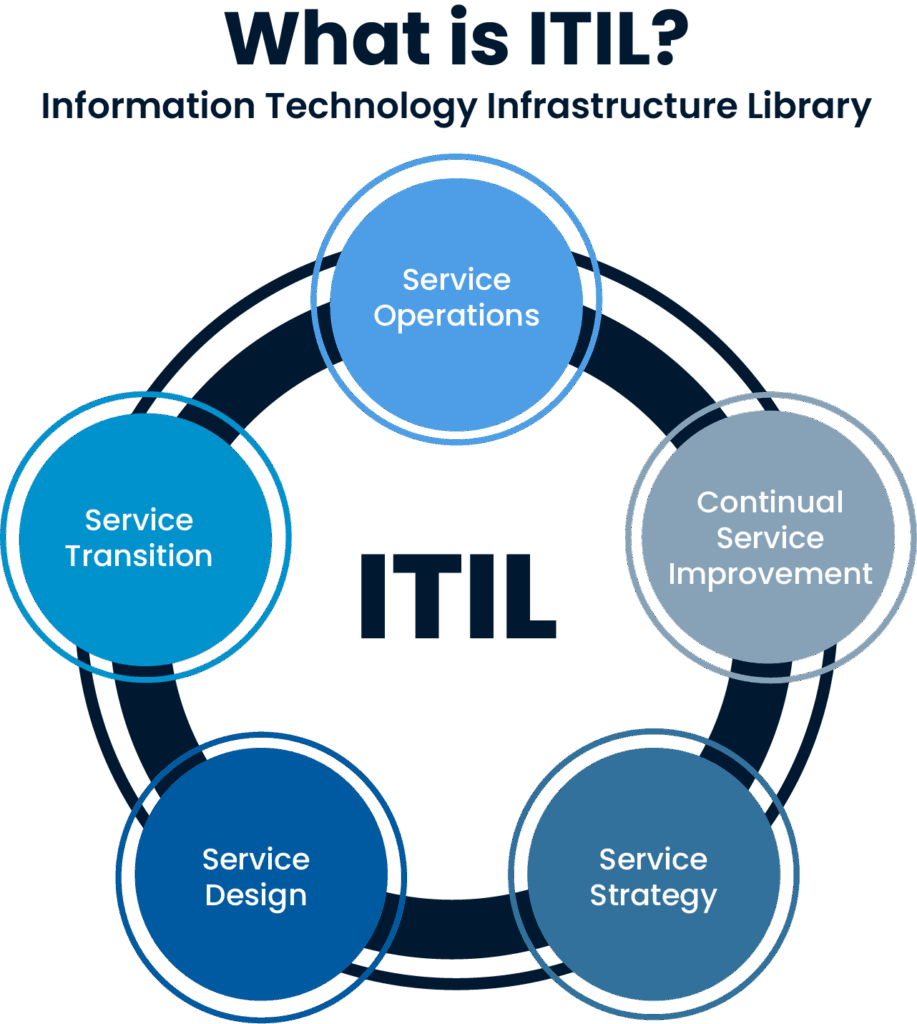What is ITIL?
ITIL (Information Technology Infrastructure Library) is a globally recognized set of best practices and process guidelines for IT service management. ITIL helps organizations deliver IT services efficiently, effectively, and with high quality. This framework focuses on managing the service lifecycle, guiding the design, transition, operations, and continual improvement of services. The goal of ITIL is to strategically manage IT services and align them with business objectives.
Relationship Between ITIL and ITSM
ITSM (IT Service Management) is an approach that covers the planning, delivery, management and improvement of IT services. ITIL is a framework for implementing ITSM and forms the basis of ITSM and standardizes its implementation. ITIL provides best practices on how service providers can better deliver IT services to their users, while ITSM manages these processes.
Evolutionary Development of ITIL
- ITIL 1 (1989) provided organizations with a fundamental view of IT service management – that is, the planning, delivery, operation, and support of IT services – enabling managers to think in terms of structured processes.
- ITIL 2 (2000) became an operational standard in ITSM, defining clearer and more actionable structures for service support (operational processes such as incident, problem and change management) and service delivery (planning processes such as capacity, availability and service level management).
- ITIL 3 (2007) took a lifecycle approach to IT service management. It detailed the processes within the framework of five basic phases: Service Strategy, Service Design, Service Transition, Service Operation and Continuous Service Improvement:
o Service Strategy: Aligns IT services with business objectives.
o Service Design: Involves planning structures such as alignment, capacity and service catalog.
o Service Transition: Provides guidance on issues such as change and configuration management.
o Service Operation: Manages the day-to-day operations of services.
o Continuous Service Improvement: Ensures regular improvement of processes with performance data.
ITIL 4 (2019) has been redesigned to respond to the needs of modern digital transformation. It has been developed to align with current approaches such as DevOps, Agile, Lean, automation, cloud and microservices. With this version, ITIL has redefined processes as flexible and adaptable guides for organizations of all sizes, rather than fixed templates.
“Service Value System” (SVS) is placed at the center of the new structure. SVS ensures that all organizational components and activities work in a coordinated manner to generate value.
ITIL 4 practices are divided into three categories according to their scope;
- General Management Practices: Covers processes such as projects and portfolios, enterprise risk, information security, continuous improvement.
- Service Management Practices: Business analysis, service design, service continuity management, service level management, service desk, monitoring and incident management, change enablement and IT asset management.
- Technical Management Practices: Technical processes covering software development and deployment, infrastructure and platform management.
“In today’s world where digital transformation is rapidly taking shape, ITIL 4 offers a powerful roadmap for businesses. To examine the benefits of ITIL 4 for businesses in more detail, check out our article titled What is ITIL 4? “Benefits for Businesses!“
Benefits of Digitizing IT Processes with ITIL Framework

Digitalization of IT processes provides various benefits to organizations.
At this point, ITIL plays an important role as a powerful framework that guides digital transformation processes and provides strategic guidance to organizations. Because it ensures that IT services are delivered, managed and continuously improved in accordance with customer needs. The role of ITIL in digital transformation is to align IT services with business strategies, optimize processes and facilitate organizational change. In this context, with digitalization, ITIL helps organizations to produce more efficient, cost-effective and sustainable solutions. Here are the critical benefits we can deliver for your business through this transformation:
Increased Efficiency
Automating manual processes helps reduce repetitive tasks and enables employees to focus on more strategic tasks, such as value generation, service portfolio management and demand forecasting. Service Design plans the scope, capacity, availability, and security of services to realize this strategy. In this way, IT becomes a strategic partner to the business, not just a support unit, and delivers direct value to the organization.
Cost Savings
Digital processes reduce the need for excessive labor and resource utilization. Optimizing business processes can also lead to significant operational cost reductions.
Better Visibility and Traceability
Digital solutions allow for easier monitoring of processes and services, enabling managers and employees to make quicker and more informed decisions.
Faster Response Times
Digitalization enables IT teams to detect and resolve issues more quickly. This boosts business continuity and increases customer satisfaction.
Compliance and Security
Digital processes can automate standards and policies to meet compliance and security requirements, helping to reduce risks and prevent security breaches.
Digitalizing processes helps businesses stay competitive in modern market conditions and enables a more strategic approach to IT service management.
Continuous Improvement
ITIL’s “Continuous Service Improvement” (CSI) approach aims to regularly monitor, evaluate and improve the performance of services. This process is supported by data such as KPIs, SLAs and customer feedback. It is based on the PDCA (Plan-Do-Check-Act) cycle and analyzes the extent to which services contribute to business objectives. Thus, operational efficiency is increased and customer satisfaction is sustained.
Digitalized processes help businesses survive in modern competitive conditions and enable IT service management to be handled more strategically. At this point, SPIDYA IT Service Management helps you transform your business’s IT operations by offering an up to date, 100% domestic and fully compliant with ITIL standards, AI-powered and modular platform. Cheetah Low-Code Platform optimizes your processes by making this transformation more effective.




